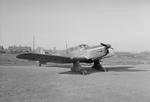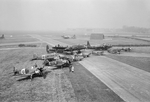Proctor
| Country | United Kingdom |
| Manufacturer | Percival Aircraft Limited |
| Primary Role | Other |
| Maiden Flight | 8 October 1939 |
Contributor: Alan Chanter
ww2dbaseDeveloped from the pre-war Gull Six and P.10 Vega Gull designs, fifteen of which had been acquired by the Royal Air Force for communications duties and for the use of overseas air attachés, the Percival Proctor aircraft was designed by Captain Edgar W. Percival to meet the Air Ministry Specification 20/38 for a radio training and communications aircraft. An all-wood low wing cabin monoplane with a fixed tailwheel and enclosed main undercarriage with seating for three, the prototype made its first flight on 8 October 1939, and was the first of 1,143 military examples to be produced during the war years for the RAF and Fleet Air Arm.
ww2dbaseThe initial production version, the P.28 Proctor I (247 built), a three–seat communications aircraft, was followed by the P.30 Proctor II (175) and P.34 Proctor III (437), both with revised cabin layout, as radio trainers without dual controls. Named originally as Preceptor, and designed to Air Ministry Specification T9/41, the P.31 Proctor IV had a larger wing and longer, deepened fuselage to accommodate four, including trainee radio operators, and provided with standard operational equipment. The increase in capacity made the Proctor IV an effective communications aeroplane too and many were later fitted with dual controls. Some 258 Proctor IVs were built and powered, as in the case of the earlier marks, by the 210-hp Gypsy Queen II engine. One experimental Proctor IV, however, with a 250-hp de Havilland Gypsy Queen engine was used as the personal transport of the Assistant Chief of Air Staff, Air Vice Marshal Sir Ralph Sorley.
ww2dbaseAs Edgar Percival's factory in Luton in Bedfordshire, during the war, was heavily involved in the sub-contracted manufacture of Airspeed Oxford aircraft and de Havilland Mosquito aircraft, many Proctor aircraft were built by sub-contractor F. Hills and Sons of Stockton, Manchester. Hill's share comprised 25 Mk Is, 100 Mk IIs, 437 Mk IIIs and 250 Mk IVs.
ww2dbaseAt the end of World War II, more than 200 Proctor I, II and III aircraft were declared surplus and prepared for disposal to civilian buyers. A few Proctor IV aircraft were, nevertheless, kept in service with communications squadrons until 1955, when the surviving aircraft were similarly sold on the civil market. Meanwhile, in 1945, three Proctor IV aircraft had been furnished to civil standards to meet an expected post-war demand from charter companies and flying clubs. This led Percival, which had become part of the Hunting Group in i944, to introduction the P.44 Proctor V. One hundred and thirty-nine aircraft of this version were built, of which four were acquired by the RAF, for use by air attachés, under the designation Proctor C.5. In addition a single Proctor 6 floatplane was built in 1946 for the Hudson's Bay Company in Canada.
ww2dbaseThree Proctors were reported to be still airworthy on the UK as late as 2001 with others held at various air museums or as candidates for restoration.
ww2dbaseSource:
David Mondey, The Hamlyn Concise Guide to British Aircraft of World War II (Chancellor Press, 1982)
World Aircraft Information Files, File 904/1 (Aerospace Publishing Periodical)
Rod Simpson, Airlife's World Aircraft (Airlife Publishing Ltd, 2001)
Last Major Revision: Sep 2017
Proctor Timeline
| 8 Oct 1939 | The prototype of the Percival Proctor, designed to British Air Ministry Specification 20/38 for a communications and radio training aircraft, made its maiden flight. |
SPECIFICATIONS
Proctor IV
| Machinery | One de Havilland Gipsy Queen II inline piston engine rated at 210hp |
| Crew | 4 |
| Span | 12.04 m |
| Length | 8.59 m |
| Height | 2.21 m |
| Wing Area | 18.77 m² |
| Weight, Empty | 1,075 kg |
| Weight, Loaded | 1,588 kg |
| Speed, Maximum | 257 km/h |
| Speed, Cruising | 225 km/h |
| Service Ceiling | 4,265 m |
| Range, Normal | 805 km |
Photographs
 |  |  |  |
Did you enjoy this article or find this article helpful? If so, please consider supporting us on Patreon. Even $1 per month will go a long way! Thank you. Share this article with your friends: Stay updated with WW2DB: |
Visitor Submitted Comments
9 Apr 2020 10:30:30 PM
Three Percival Proctors were heavily modified including adding gull wings to resemble Stuka dive bombers in the Battle of Britain movie. Surprisingly these "Proctrukas" were allowed to fly, but apparently flying characteristics were not good and the flying footage was not used. Large scale RC models were used instead.
4 Aug 2020 06:54:53 PM
In 1941 The Scots College, Sydney raised money for a Proctor which was named after the school. Colonel Moore-Brabazon of the British Ministry of Aircraft Production was the contact. I wonder if there is any info available about what happened to it? Thanks
All visitor submitted comments are opinions of those making the submissions and do not reflect views of WW2DB.
- » Autumn 2024 Fundraiser (7 Nov 2024)
- » Nobel Peace Prize for the Atomic Bomb Survivors Organization (11 Oct 2024)
- » Wreck of USS Stewart/DD-224 Found (2 Oct 2024)
- » WW2DB's 19th Anniversary (29 Dec 2023)
- » See all news
- » 1,150 biographies
- » 337 events
- » 43,914 timeline entries
- » 1,241 ships
- » 350 aircraft models
- » 207 vehicle models
- » 372 weapon models
- » 123 historical documents
- » 260 facilities
- » 470 book reviews
- » 28,532 photos
- » 432 maps
Thomas Dodd, late 1945
Please consider supporting us on Patreon. Even $1 a month will go a long way. Thank you!
Or, please support us by purchasing some WW2DB merchandise at TeeSpring, Thank you!
13 Jun 2019 03:30:58 AM
My Dad served right through WW2 in the merchant navy. After the war he worked for Percival’s (Luton) and designed the undercarriage for a Proctor. I have several photos. I wonder if anyone could identify the model if they saw a photo?